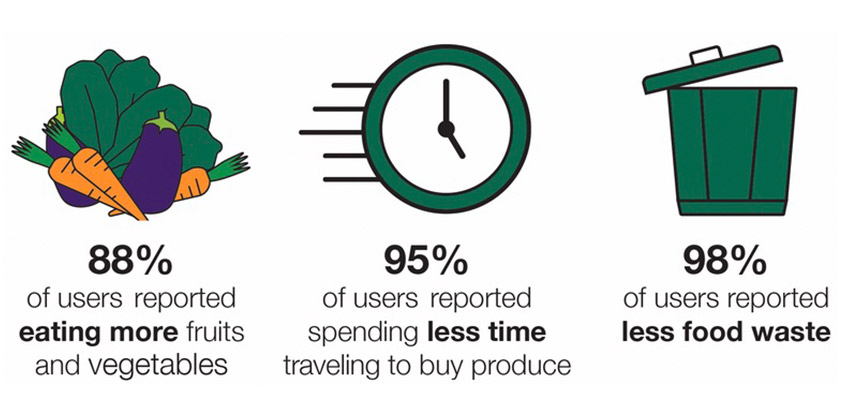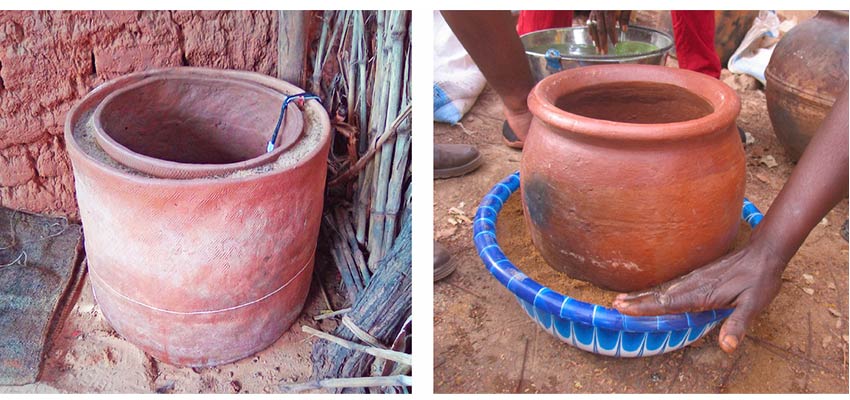
Original blog post on Agrlinks website
A clay pot cooler is a simple technology that can improve the shelf life of fruits and vegetables in arid regions, without the need for electricity. In addition to demonstrating the performance of these devices, MIT D-Lab, the World Vegetable Center and the Institut d’Economie Rurale (IER) have developed a training program in Mali to raise awareness and encourage the adoption of clay pot coolers, thereby helping families to reduce food waste, save time and money, and improve household nutrition. In celebration of the International Day of Awareness of Food Loss and Waste, we would like to share information about this program.
Among the nearly 300 participants who have attended one of the 11 half-day clay pot cooler training sessions, 73% have begun using clay pot coolers since attending the training. Training participants include clay pot makers and sellers, along with fruit and vegetable producers, vendors and household consumers. The training sessions consist of instruction on the following topics:
- The importance of proper fruit and vegetable storage
- How evaporative cooling and clay pot coolers work
- Hands-on activity to assemble clay pot coolers with locally available materials
- Best practices for using clay pot coolers
The participants are given a copy of the Guide to Assembling, Using and Maintaining Clay Pot Coolers in the relevant local language to take with them after the training.
A key aspect of the training program is to generate both supply and demand for clay pot coolers in communities. Supply was created by training 54 clay pot sellers, who then sold nearly 2,000 clay pot coolers in the 10 months after the series of half-day training workshops were delivered. Demand for clay pot coolers was generated not only through training community members who could benefit from improved fruit and vegetable storage, but also through an additional 4,300 people who received information about clay pot coolers from the workshop participants. Through this approach, the adoption of clay pot coolers can be sustainably scaled without the need for subsidies or developing a distribution network for the technology.


Prior to launching the training program, the team identified several configurations of clay pot coolers that work well for storing and preserving leafy greens for up to six days (typically, they spoil in one to two days) and eggplants for up to 15 days (which typically spoil in three days). An important finding is that, in addition to the better known clay pot-in-pot or “Zeer pot” design, a clay pot-in-dish design was shown to provide similar performance. This finding is critical because the clay pot-in-dish configuration is much easier to assemble with locally available materials. Zeer pots require two clay pots that fit together with room for sand between them. The pot-in-dish design is more flexible: any clay pot in a dish — ceramic or plastic — will do. This flexibility makes the pot-in-dish design more accessible, as no custom pot production is required. More detail on these shelf life studies can be found in the report Clay Pot Coolers: Preserving Fruits and Vegetables in Mali: Report 2016-2021.

Clay pot coolers have tremendous benefits for communities in arid climates, where hot, dry air contributes to both the need for better fruit and vegetable preservation and the solution. In these arid climates, not only are fruits and vegetables most susceptible to rapid dehydration and degradation, but off-grid communities are also particularly vulnerable to the impacts of climate change and susceptible to food insecurity. Because clay pot coolers function through the principle of evaporative cooling, by which water evaporating from the surface of the device removes heat and cools the produce inside the clay pot cooler, they do not require electricity to operate and are most effective in hot and dry climates.
Expanding the dissemination of clay pot coolers through this training program has great potential to benefit communities in arid regions by enabling reduced food waste, time and money savings, and improved nutrition. If you are interested in learning more or exploring partnerships to disseminate clay pot coolers, please contact Eric Verploegen, research engineer at MIT D-Lab.
More information
The report Clay Pot Coolers: Preserving Fruits and Vegetables in Mali: Report 2016-2021 summarizes the activities of the clay pot cooler project in Mali between 2016 and 2021
MIT D-Lab Evaporative Cooling Research
Contact
Eric Verploegen, MIT D-Lab Research Engineer

